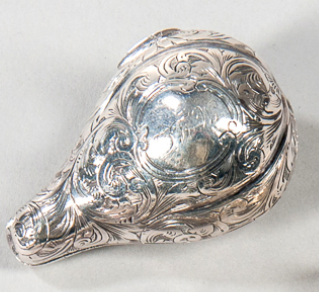Nutmeg Graters - Precious Collectors' Pieces
- Matthew Lafite FRSA FSA Scot FRSAI
- Sep 29, 2019
- 3 min read
Any well-established member of English gentry or 'Society' ensured they were well-equipped with the finest silver nutmeg grater - but the question is - "Why?".
The answer - "Fashion".
Nutmeg was discovered on a tiny group of Indonesian islands in the 16th century and rose to popularity during the 17th century when it became all the rage to flavour your drink - be it wine, punch, tea or hot chocolate - with this heady and enchanting spice. At the time, nutmeg was only found in Indonesia and thus commanded high prices when sold all the way back in England.
Specific graters for nutmeg started to be produced from the middle of the 17th century, constructed from wood and bone, with only the most well-heeled of clientele possessing solid silver examples. The earliest form of English silver nutmeg graters are seen from around the time of the Restoration, are of London manufacture and are in tubular form or 'hearts' and 'tear drops'.

Above: A William and Mary c.1690 'tubular' nutmeg grater (also possibly a tobacco rasp) sold at Woolley and Wallis Auctions in 2004 for GBP 6,000.00 excluding commission. Lafite Fine Silver has a range of contemporary examples in stock.
During the 18th century the production of nutmeg graters expanded to include silversmiths from Birmingham too and designs evolved to elliptical and rectangular forms.
Above left: A nutmeg grater engraved with a crest for Lambert of Surrey - Sir Daniel Lambert served as Lord Mayor of London in 1741. Above right: A fine quality late 18th century London made nutmeg grater of rectangular form with Neo Classical bright-cut decoration. Two hinged covers open to reveal an integral blue steel rasp. Both examples are sold.
From the beginning of the 19th century up until the end of the reign of William IV, nutmeg graters were produced in similar styles and one does see the influence of the Birmingham box makers in their construction. Famous firms such as Nathaniel Mills, the Willmores and Joseph Taylor to name but a few were influential in the production of such wares.
Above: An example of three nutmeg graters produced between 1820 and the end of the reign of William IV (1837). The left is of Birmingham manufacture. The centre with attractive 'diaper' decoration, and the right by the famous firm of Nathaniel Mills with a wonderful ribbed body and cast floral border.
Perhaps the most hotly contested sector of the nutmeg grater market certainly at present and for the last decade at least, are the Victorian naturalistic forms produced by a small handful of skilled workshops. The most sought after firm being Hilliard and Thomason of Birmingham. Forms range from nuts, melons and fruit to shells and nutmegs themselves.

A 'strawberry' form nutmeg grater by Hilliard & Thomason of Birmingham. One of the rarest and most collectable Victorian 'naturalistic' form graters.

A 'melon' form nutmeg grater, also by Hilliard & Thomason. The exterior with chased floral and foliate decoration.
Above left: A 'nutmeg' form nutmeg grater by Hilliard and Thomason. Above centre and right: A 'clam shell' form nutmeg grater by Hilliard and Thomason.
These delightful little examples of masterfully crafted status symbols, make not only wonderful items for collectors, but speak to the accepted conventions of elite Society. Small and perfectly formed.
Some examples of nutmeg graters which we currently have for sale:
Left: A George IV 'barrel' form nutmeg grater. Centre: A Scottish 'egg' form grater, marked with incuse duty mark and Edinburgh town mark. Right: A Hilliard & Thomason 'pear' nutmeg grater.











































